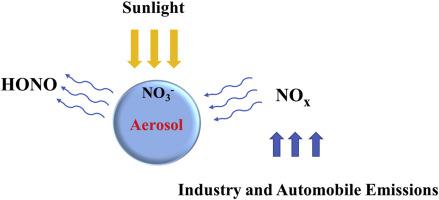当前位置:
X-MOL 学术
›
Atmos. Environ.
›
论文详情
Our official English website, www.x-mol.net, welcomes your feedback! (Note: you will need to create a separate account there.)
Budget of nitrous acid and its impacts on atmospheric oxidative capacity at an urban site in the central Yangtze River Delta region of China
Atmospheric Environment ( IF 5 ) Pub Date : 2020-10-01 , DOI: 10.1016/j.atmosenv.2020.117725 Xiaowen Shi , Yifeng Ge , Jun Zheng , Yan Ma , Xinrong Ren , Yuchan Zhang
Atmospheric Environment ( IF 5 ) Pub Date : 2020-10-01 , DOI: 10.1016/j.atmosenv.2020.117725 Xiaowen Shi , Yifeng Ge , Jun Zheng , Yan Ma , Xinrong Ren , Yuchan Zhang

|
Abstract In this study, we used a wet chemistry based long-path absorption spectroscopy method to measure HONO in Changzhou, in the central Yangtze River Delta region (YRD) of China, from April 3–24, 2017. During the observation period, the average HONO mixing ratio was 1.55 ± 1.21 ppbv. In addition, the average OH formation rates of the photolysis of HONO, O3, HCHO and H2O2 along with ozonolysis of alkenes were 7.84 × 106, 2.02 × 107, 7.41 × 105, 3.79 × 105 and 1.51 × 106 molecules cm−3 s−1, respectively. At nighttime, the average conversion rate from NO2 to HONO was determined to be ~0.018 h−1. In this work, the primary emission rate of HONO was determined by the ratios of HONO to nitrogen oxides (NOx = NO + NO2) within freshly emitted plumes (NO/NOx > 0.85) and a value of ~0.69% was obtained. The sources of HONO were further investigated through a box model utilizing the Master Chemical Mechanism. The simulation results show that primary emissions contributed only ~12.3% of the total HONO budget during daytime but a substantial portion (31.4%) at night. Comparing to heterogeneous HONO sources, the gas-phase NO + OH reaction was the less important HONO source, with a contribution of 14.2% at night and 28.7% during the daytime. Heterogeneous reactions of NO2 on various surfaces (mostly the ground surface) were responsible for most of the observed HONO, i.e., 34.7% during the day and 54.4% at night. Overall, nighttime HONO can be reasonably explained by aforementioned mechanisms. However, daytime HONO cannot be fully accounted for without the consideration of nitrate photolysis, which contributed ~24.1% of the daytime HONO according to the model simulation. Our findings highlight that photolysis of particulate nitrate could be an important source of daytime HONO, providing a channel to cycle NO and OH radical back into the photochemical system and further enhancing the atmospheric oxidative capacity within the air shed of a typical industrial zone of China.
更新日期:2020-10-01


























 京公网安备 11010802027423号
京公网安备 11010802027423号